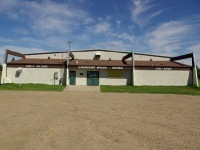by Joan Champ
In the summer of 1969, my family bought a house on Baker Place in the Crescent Heights subdivision of Prince Albert. It was an attractive, pale green, three-bedroom bungalow on a “wedge” lot backing onto Twenty-Second Street East.
My parents paid $24,000 for our new home. My father, Jim Perkins, who had originally worked for Kimberly-Clark, first in Longlac, Ontario, and later in Redding, California, had accepted a position with Prince Albert Pulpwood/Woodlands Enterprises, the company that supplied wood to the pulp mill.
Crescent Heights, established in 1960 on the southeast edge of the city, was the first subdivision in Prince Albert. That year, the City of Prince Albert entered into a major Land Assembly and Development Agreement with the Province of Saskatchewan for the development of residential housing on 675 acres that had once been the jail farm.
Crescent Heights exemplified the new neighbourhood concept of urban design that had gained wide acceptance in most Canadian cities by the late 1950s and early 1960s. Subdivisions were characterized by single-family homes on small plots of land, surrounded at close quarters by similar dwellings.
The street pattern was curvilinear, with crescents and cul-de-sacs, considered to be safer than the grid street system as it discouraged high-speed driving in residential areas. Stores and other amenities were not generally within walking distance of most homes.
The focal point of the subdivision was an elementary school with surrounding parkland and recreational facilities. In the case of Crescent Heights, it was John Diefenbaker School, opened in 1965.
The sale of lots in the new Crescent Heights subdivision started in February 1961. City council agreed to pay the provincial government $62,190 for the land, which was composed of 226 lots. The boundaries were listed as Sixth Avenue East and Twenty-Second Street at the golf course.
The second phase of Crescent Height’s development occurred in the winter of 1964-1965, with the sale of 24 lots to contractors. Most of these lots were in the Bradshaw Place area, with eight show-home sites scheduled for Fraser Place, south of Branion Drive.
Phase Three of Crescent Heights began in 1966, shortly after the announcement that a pulp mill was to be constructed on the outskirts of Prince Albert. On April 28, 1966, officials from Parsons and Whittemore, the New York-based company in charge of construction of pulp mill, came to Prince Albert to decide on the location of approximately 200 homes for mill employees. Karl F. Landegger, company president, told the Prince Albert Daily Herald that it was most important to provide suitable accommodation for skilled mill workers, many of whom were then employed in similar work elsewhere in Canada, and who would have to be enticed to work and settle in Prince Albert.
Parsons and Whittemore had no desire to create a “company town” outside the city. Rather, it was “most necessary to consider both the sociological and economic aspects of the ultimate location of these homes.”
Parsons and Whittemore negotiated with several Saskatchewan-based home construction companies regarding the cost of construction of about 200 homes for its employees, some of whom would be arriving shortly after the construction of the mill got underway that summer.
Eventually, the company organized Forest Gate Homes, Ltd. to arrange the financing for the building of 60 to 100 houses in 1966, and the balance the following year. The homes – mainly three-bedroom bungalows – would cost between $10,000 and $12,000 to build. They would be sold or rented to mill employees at “equitable rates,” Landegger said.
By April of 1967, there were 270 homes in Crescent Heights subdivision, with 50 more lots available, for a total of 330 residences. Four vacant lots at the intersection of Branion Drive and Sixth Avenue East were available for the construction of a service station. Some of the other businesses that sprang up on that location were a grocery store (the IGA), a beauty salon, a bank (CIBC), and – my favorite – the Quarter Moon, located at 615 Branion Drive It was the place to go for burgers, milkshakes, and ice cream cones. It also served as a confectionary and a post office.
My family enjoyed 28 happy years in our Crescent Heights home on Baker Place. The most unique feature of our home was the row of spruce trees that served as our backyard “fence.” When we moved in, the trees were about 3 feet tall.
By the late 1990s, they were well over 20 feet tall. In 1971, my father, a non-carpenter, built a typical 1970s, wood-paneled “rec room” in the basement. Not long afterwards, he added a sauna. There were very few evenings that he didn’t spend half an hour in that sauna where, he said, some of his best ideas came to him. My parents sold the house in 1997 and moved into a penthouse apartment.
Contact: joanchamp@shaw.ca


